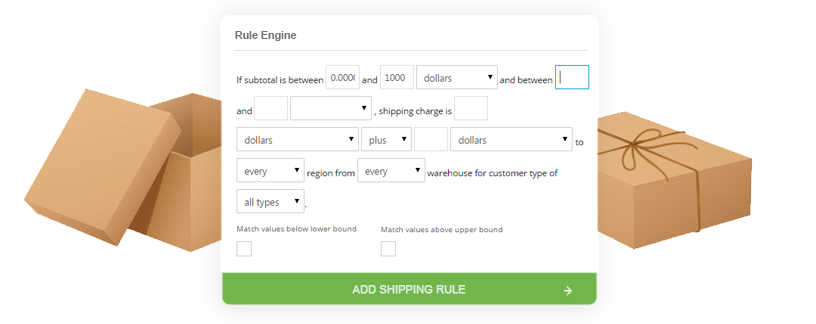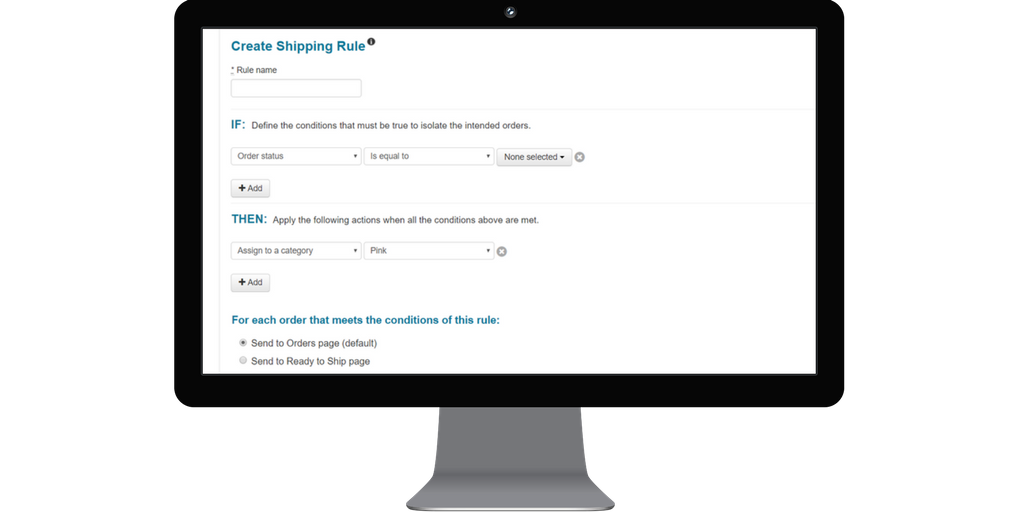Shipping is one of the largest investments for e-commerce sellers. You’re probably aware the actual financial cost of shipping is just the beginning. There is also the time invested in choosing the correct carriers and packing materials, delivery time frames, printing labels and packing slips, and more.
Whether you have one person dedicated to managing your shipping, or a whole team, the hours invested in getting your products out the door really add up. There are ways to streamline these processes to save time, as well as potentially save money on actual shipping costs, with some smart management. Let’s explore a couple ways you can make this happen.
Automate your shipping workflow
Setting up automation isn’t as complicated as you might think. It comes down to building IF/THEN statements to tell shipping software what to do. Solutions like ShippingEasy, integrated with AmeriCommerce, can help you easily set up a number of automation rules to streamline your shipping workflow.

An example that is particularly relevant for B2B businesses that sell higher ticket items is creating a rule which adds a signature confirmation requirement to high value orders. Automating tasks like this can save you tons of time on your shipping, and avoid headaches down the line.
Since AmeriCommerce allows you to manage multiple stores in one place, another way to use shipping automation is to customize customer communications by store. Let’s say you sell via multiple storefronts, an Amazon store, eBay store, and a monetized blog. Using automation rules, you can create specific confirmation and shipment notification emails to communicate differently to customers purchasing from different channels.

For example, you may want to invite Amazon and eBay customers to review your store or products on those platforms, while customers from your other storefronts and blog may get product recommendations to encourage repeat business. Using automation rules, you can ensure that customers receive a different version of those communications, specifying different calls to action on each email depending on where they purchased from.
So how does this all come together to make your business operations more efficient? First, take a look at these steps when thinking about how to apply automation rules to your business practices.
Identify the biggest sources of your volume
Focus on streamlining your shipping process in the areas that account for a large portion of your volume. After all, this most likely consumes the greatest amount of your time and resources. For example:
- Product SKU A might be a best-seller
- Store B accounts for 50% of your sales
- Many orders are sourced from Destination C
Map your current processes
Determine what steps you take to receive and ship out these types of orders. You could think about it, write it out, or illustrate it with a diagram. Specifically, consider any decisions that must be made on an order-by-order basis and if any of the guidelines you use can be generalized across a class of orders. In most cases, discovered patterns can be translated to automation rules (discussed in detail further below). For example:
- Product SKU A fits in a specific box
- Store B requires a unique packing slip
- Orders going to Destination C use a certain carrier/service
 Analyze your findings and consider change
Analyze your findings and consider change
Decide if your current process for handling this volume is the most efficient use of your resources. If not:
- What choices are your team making that could be standardized?
- Are there any steps that can be eliminated, especially if automated?
Standardize your processes
Sometimes physical changes will need to be made to your operation. Combined with using automation rules to reduce the number of conscious decisions that need to be made and you have a recipe for greater profitability.
Generally speaking, the less a person “touches” an order, the more you’ll save on operational costs. These are some areas that can be optimized in most warehouses:
- Inventory: if you sell it, keep it in stock. Know where products are stored and make them easy to find. Action items:
- Routinely verify your levels; keep individual SKUs in their own bins and in consistent locations.
- Movement: store your products where they’re most needed and easiest to access. Handle product as little as possible.
- Action items: keep fast moving inventory close at hand; keep bins close to the ground and within easy reach; don’t store away pallets that will be unloaded soon.
- Information: make sure actions are well informed.
- Action items: make customer instructions readily available to shippers; verify order details before picking and packing.
Taking all of the above into consideration can help you optimize where and when to implement automation to drastically cut the time you spend processing orders and shipping. These saved hours translate into time you can focus on other efforts, such as marketing and building your business.
Coordinate your shipping and inventory
You can’t ship products you don’t have, and not having a firm grip on your inventory levels can be a shipping and customer service nightmare. Gone are the days when manually updating spreadsheets and Google Docs will suffice for managing your inventory. According to National Retail Federation’s latest study, 21.3% of inventory shrink is due to administrative and paperwork error. Who wouldn’t love to reduce a fifth of their inventory losses?
The speed of business on the internet means you need to have systems in place that get your shipping and inventory talking to each other. As more businesses plan to expand inventory to meet customer demand (54% plan to expand the number of inventory SKUs carried over the next five years), coordinating this without the human error element becomes all the more important.

First and foremost, you need to set low-stock alerts for your inventory. Quality inventory management software, like what you find with ShippingEasy plus AmeriCommerce, allows you to set custom levels to give you ample time to reorder stock, which should be based on historic volume of sales. Automating this process leaves less room for error and can help you avoid a customer service catastrophe.
Another way to tie your shipping and inventory together is to append product tags and categories to your SKUs. This streamlines the automation process by letting you group separate SKUs under one moniker, then apply rules to those tags or categories.
Examples of a tag would be something like “fragile,” or “top seller.” With tags like these in place, you can create packaging automation rules based on them, rather than basing them on individual SKUs. When it comes time to process shipments, your system knows which packaging requirements or shipment methods to use based on the rules you set up.
Product categories take tags one step further, because they act as a "Master SKU" that you can assign to multiple Product SKUs. Product Categories expand the possibilities of automation rules, streamline custom forms, and make managing stock levels easier:
- Shipping Rules: without Product Categories, you could write a Shipping Rule that acts on orders based on individuals SKUs. However, if you sell many similar Products, each with a unique SKU, you can use a Product Category to apply that same action to a wider range of Products.
- Customs Forms: simplify international shipping by saving pertinent customs information, such as item description, harmonized code, country of manufacture, and declared value. Rather than managing this data for individual Products, group similar SKUs with a Product Category for easy updates in the future.
- Stock Levels: when Products are grouped - such as by type, location, or Supplier - you can quickly filter to these Products in your Product Catalog to view the stock levels across those related Product SKUs. This simplifies inventory reconciliation and restocking.
When you have complicated products, using product tags and categories can literally cut hours per week, removing manual processes and ensuring accuracy in your inventory and shipping workflows.
Arguably the most important element of managing your inventory is syncing your inventory quantities across all of your sales channels. Disparate channels that don’t communicate with one another can be an inventory nightmare. To streamline this, you need one hub to pull in quantities from all of your sales channels, reconcile with your sales numbers, and communicate back to those sales channels, if possible, updating quantities and making sure you don’t sell products you don’t have in stock. At minimum, you should be pulling quantities from your channels and managing them in one place, even if you can’t update the quantities on those channels automatically. An inventory management solution helps with this immensely.
These are just a few impactful ways you can streamline your shipping processes to make your B2B e-commerce business run more smoothly and efficiently. For a more in-depth analysis on how to streamline your e-commerce shipping, download ShippingEasy’s free Definitive Guide to E-Commerce Shipping.